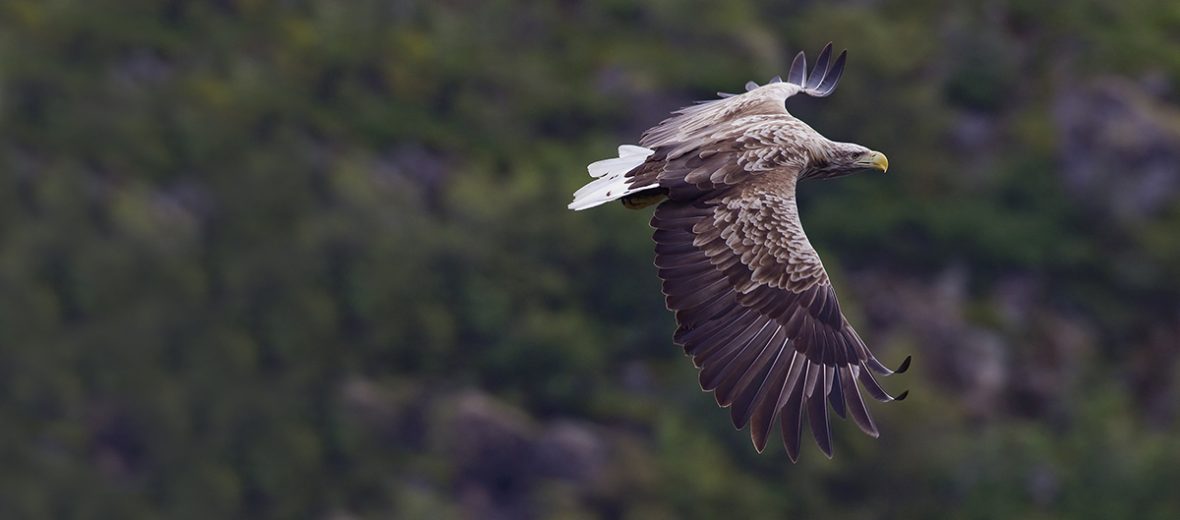
The Eurasian white-tailed eagle, aka Ern, Erne, gray sea eagle, white-tailed sea-eagle, or white-tailed eagle, is considered to be the 4th largest eagle in the world. #1 is the Philippine eagle. These birds of prey can be found in Iceland, Greenland, Europe, Asia, and Africa. Even though they face the threats of habitat loss and destruction at the hands of the timber industry and renewable energy; hunting; trapping; recreational activities that disturb their nesting grounds; invasive species (and with them disease, predation, and competition for food); and pollution (ground, air, and water), these birds are still listed as Least Concern by the IUCN.
First the Stats…
Scientific name: Haliaeetus albicilla
Weight: Up to 15.2 lbs.
Length: Up to 37 inches
Wingspan: Up to 8 feet
Lifespan: Up to 42 years
Now on to the Facts!
1.) Their estimated population is around 60,000 wild individuals, and that number is increasing.
2.) These birds are considered close relatives of the bald eagle.
3.) Eurasian white-tailed eagles prefer low coastal spots, coastal marshes, and estuaries with forested areas, secluded woodlands, or groups of mature growth trees. They also like marshes, lakes, river systems, and expansive, farmland that is not often disturbed.
4.) The male’s calls are a ‘krick-krick-krick’ or a ‘gri-gri-gri’. Whereas the females call is a deeper sounding ‘krau-krau-krau-krau’ or ‘gra-gra-gra-gra’. Typically, pairs will call out a duet during early spring, from a perched position or in flight.
5.) Their alarm calls tend to be up to 4 short, but loud ‘klek’ and/or ‘klee’ sounds.
But wait, there’s more on the Eurasian white-tailed eagle!
6.) A group of eagles is called a convocation or aerie.
7.) Since these birds of prey are very territorial, fights over territories can sometimes have lethal consequences.
Did you know…?
These large eagles can fly at speeds of up to 43 mph.
8.) Mostly younger or juvenile birds can become gregarious and flock together into convocations of up to 10 individuals.
9.) During the breeding season these critters can gather into aeries of up to 40 individuals.
10.) Typically an exhibit of the lay-and-wait style of hunting is seen, where they will perch up on high and then dive down to the water’s level to snatch up a fish.
But wait, there’s more on the Eurasian white-tailed eagle!
11.) Fish, water birds, small animals – like rats, mice, and carrion (dead animals) are all on the menu.
12.) White-tailed eagles are monogamous (mate for life).
Did you know…?
There are numerous Gaelic names for these birds of prey, like iolar sùil na grèine which translates to “eagle of the sun’s eye.”
13.) Breeding season in the north lasts from April – September, while in the south they breed from January – July.
14.) Nests typically measure a whopping 3.3 feet across and up to 6.6 feet deep! The nests are lined with plant clippings, moss, seaweed, and/or wool.
15.) Several nests are constructed throughout their territory and utilized in different years.
But wait, there’s still more on the Eurasian white-tailed eagle!
16.) Females lay up to 2 eggs that hatch in up to 42 days.
17.) In the Shetland Isles, in Scotland, the fishermen there believe that whenever you see a sea eagle, fish would rise to the surface, belly up. This has led to some fishermen using Eurasian White-Tailed eagle fat, rubbed on their bait, to increase their chances of a catch.
18.) The Eurasian white-tailed eagle is the national bird of Germany.
19.) In true eagle fashion, these birds will steal food from other creatures, like cormorants, corvids, gulls, ospreys, and even otters. This is known as kleptoparasitism.
20.) The Anglo-Saxon word for the white-tailed eagle is “erne” which means “soarer.”
Now a Short Eurasian White-Tailed Eagle Video!
Be sure to share & comment below! Also, check out the Critter Science YouTube channel. Videos added regularly!
Want to suggest a critter for me to write about? Let me know here.
Some source material acquired from: Wikipedia & IUCN
Photo credit: Yathin S. Krishnappa



